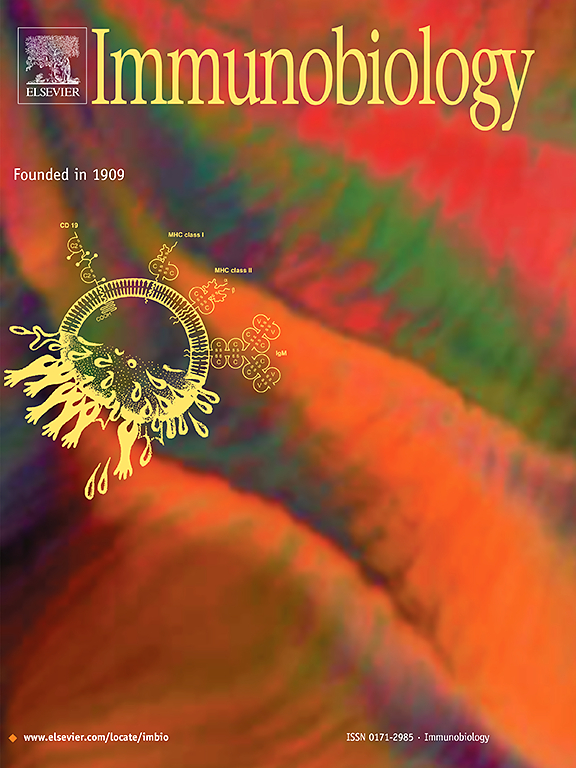Shared pyroptosis pathways and crosstalk genes underpin inflammatory links between periodontitis and atherosclerosis
IF 2.3
4区 医学
Q3 IMMUNOLOGY
引用次数: 0
Abstract
Objective
This study aimed to identify crosstalk genes shared between periodontitis (PD) and atherosclerosis (AS) and to investigate their potential connections with pyroptosis-related genes. The goal was to uncover common regulatory mechanisms underlying these two inflammatory conditions.
Methods
Gene expression datasets for PD (GSE10334) and AS (GSE43292) were retrieved from public databases. Following batch effect correction and normalization, differential expression analysis was conducted using the limma package in R. Functional enrichment analysis was performed with the clusterProfiler package to identify key pathways, while heatmaps and pathway networks were constructed to visualize the relationships among pyroptosis genes and crosstalk genes. Weighted gene co-expression network analysis (WGCNA) was applied to identify critical modules, and the diagnostic potential of core genes was evaluated via receiver operating characteristic (ROC) analysis. Protein-protein interaction (PPI) networks were also constructed to explore molecular interactions.
Results
A total of 28 downregulated and 105 upregulated genes were identified in the PD dataset, while the AS dataset revealed 55 downregulated and 56 upregulated genes. Thirteen crosstalk genes were identified between the two datasets. Enrichment analyses of these crosstalk genes highlighted their involvement in inflammation- and immune-related pathways. The observed association of pyrototic phenotypes with PD and AS indicated significant overexpression of pyroptosis-related genes such as CASP1, NLRP3, and GSDMD, suggesting the participation of pyroptosis in the progression of disease. The WGCNA suggested that pyroptosis genes are closely relevant to immune responses and cell death processes. Data up to October 2023 were used to perform receiver operating characteristics (ROC) curves to confirm the diagnostic value of the enriched core genes, and all of them presented AUC values >0.8, which meant that they were key genes with effective diagnostic power.
Conclusion
We report a novel study that identifies differentially expressed genes and pyroptosis-related pathways in PD and AS with shared inflammatory mechanisms. These results underscore the crucial role of pyroptosis in disease progression, suggesting its potential as a focus of diagnostic and therapeutic strategies. These findings provide insights for dissecting the molecular basis of inflammatory diseases.
共同的焦亡途径和串扰基因支持牙周炎和动脉粥样硬化之间的炎症联系
目的研究牙周炎(PD)和动脉粥样硬化(AS)之间的串扰基因,并探讨它们与热作用相关基因的潜在联系。目的是揭示这两种炎症的共同调节机制。方法从公共数据库中检索PD (GSE10334)和AS (GSE43292)基因表达数据集。在进行批效应校正和归一化后,使用r中的limma软件包进行差异表达分析,使用clusterProfiler软件包进行功能富集分析以识别关键通路,同时构建热图和通路网络以可视化焦亡基因和串扰基因之间的关系。应用加权基因共表达网络分析(WGCNA)识别关键模块,并通过受试者工作特征(ROC)分析评估核心基因的诊断潜力。蛋白质-蛋白质相互作用(PPI)网络也被构建来探索分子相互作用。结果PD数据集中共发现28个下调基因和105个上调基因,而AS数据集中共发现55个下调基因和56个上调基因。在两个数据集之间鉴定出13个相声基因。这些串声基因的富集分析强调了它们参与炎症和免疫相关途径。观察到的焦亡表型与PD和AS的关联表明,焦亡相关基因如CASP1、NLRP3和GSDMD显著过表达,提示焦亡参与了疾病的进展。WGCNA表明,焦亡基因与免疫反应和细胞死亡过程密切相关。利用截至2023年10月的数据进行受试者工作特征(receiver operating characteristic, ROC)曲线,确认富集的核心基因的诊断价值,所有核心基因的AUC值均为>;0.8,为具有有效诊断能力的关键基因。我们报道了一项新的研究,发现了PD和AS中具有共同炎症机制的差异表达基因和焦热相关途径。这些结果强调了焦亡在疾病进展中的关键作用,表明其可能成为诊断和治疗策略的焦点。这些发现为解剖炎症性疾病的分子基础提供了见解。
本文章由计算机程序翻译,如有差异,请以英文原文为准。
求助全文
约1分钟内获得全文
求助全文
来源期刊

Immunobiology
医学-免疫学
CiteScore
5.00
自引率
3.60%
发文量
108
审稿时长
55 days
期刊介绍:
Immunobiology is a peer-reviewed journal that publishes highly innovative research approaches for a wide range of immunological subjects, including
• Innate Immunity,
• Adaptive Immunity,
• Complement Biology,
• Macrophage and Dendritic Cell Biology,
• Parasite Immunology,
• Tumour Immunology,
• Clinical Immunology,
• Immunogenetics,
• Immunotherapy and
• Immunopathology of infectious, allergic and autoimmune disease.
 求助内容:
求助内容: 应助结果提醒方式:
应助结果提醒方式:


